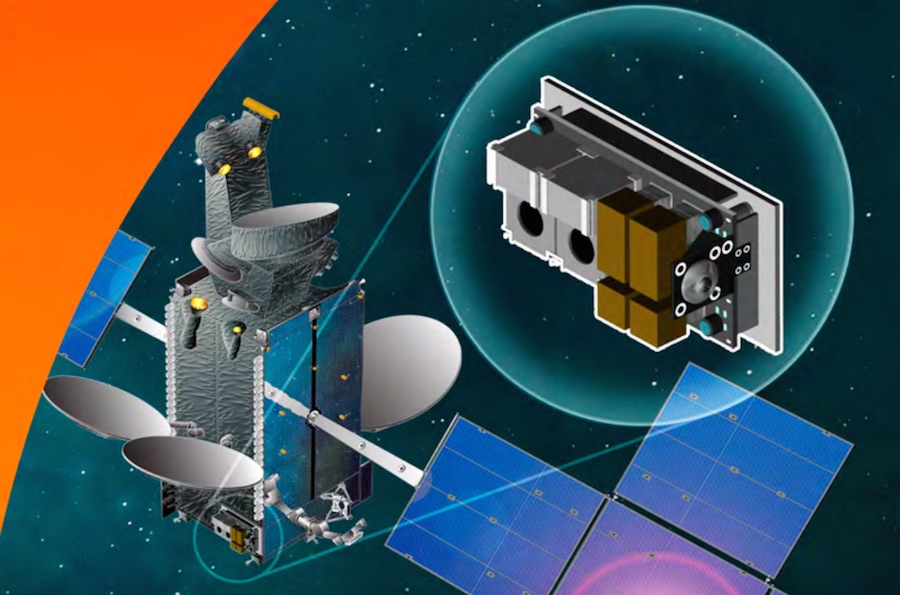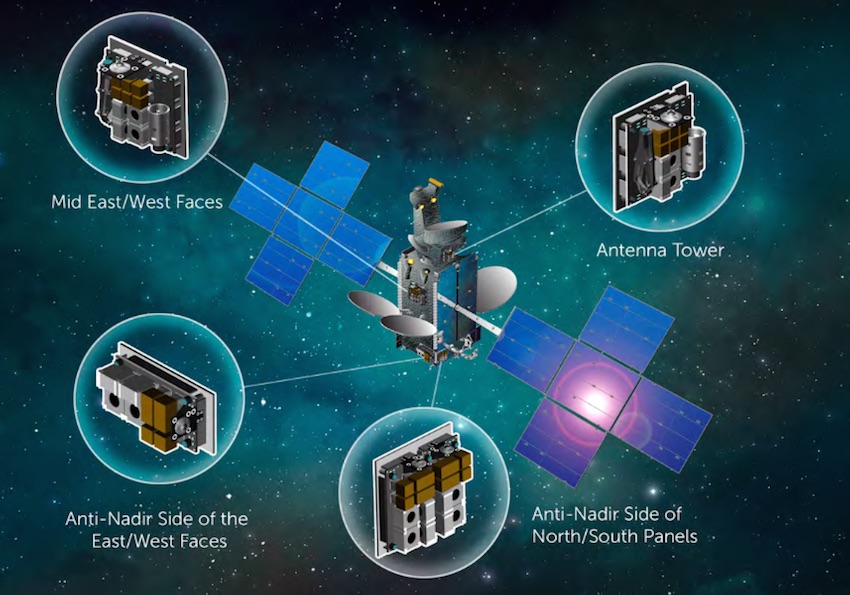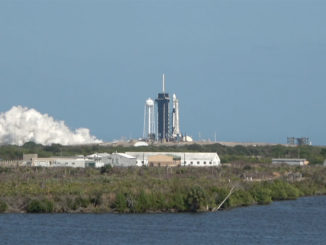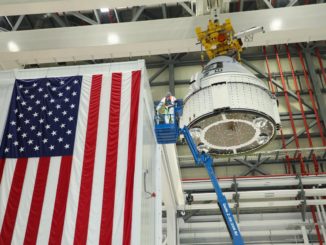
A previously-undisclosed payload funded by a U.S. military research agency rode into orbit with a Spanish communications satellite on SpaceX’s most recent Falcon 9 rocket launch March 6, officials said Friday.
The small spacecraft was fastened inside the Hispasat 30W-6 communications satellite, then ejected soon after the Falcon 9’s primary payload deployed in orbit following liftoff from Cape Canaveral.
Officials from Space Systems/Loral and NovaWurks, two companies involved in the project, acknowledged the existence of the secret secondary satellite after publicly-available orbital data published by the U.S. military registered an unexpected object attributed to Tuesday’s launch named PODSat.
The companies declined to release details about the secondary satellite’s mission or design, and a spokesperson for the Defense Advanced Research Projects Agency, or DARPA, did not respond to multiple requests for information regarding the PODSat mission.
“SSL’s innovative secondary payload release system was successfully tested on Hispasat 30W-6,” said Wendy Lewis, a spokesperson for SSL, based in Palo Alto, California. “This was an R&D (Research and Development) mission not related to the ongoing operation of the Hispasat satellite. Rideshare arrangements such as this are becoming more common as they help defray the cost of launch and drive innovation for our industry.”
“We are not disclosing further details about the secondary payload at this time but we are optimistic about its potential as part of the SSL future R&D roadmap,” Lewis said in a written statement in response to Spaceflight Now questions.
SSL provided a ride for the PODSat testbed satellite built in partnership with NovaWurks, headquartered in Los Alamitos, California. According to its website, NovaWurks specializes in assembly of small spacecraft using “satlets,” cellular components that engineers can connect together to create custom and conformable payloads.
James Greer, chief operating officer at NovaWurks wrote in an email Friday that the PODSat spacecraft is functioning according to plan, but he declined to answer questions on the satellite’s mass, design, or purpose.
“We are very pleased with the successful launch and deployment of PODSat over that past several days. Everything is going well and we continue to receive positive data with each pass,” Greer said.
“However, as this is a DARPA project, we are not at liberty to discuss any specifics or details relative to the mission, except as approved by DARPA,” Greer said.
NovaWurks developed what it calls the Hyper-Integrated Satlet, or HISat, architecture with funding from DARPA’s Phoenix program, chartered to find lower-cost ways of building satellites and delivering them to space. Each HISat cell is a self-contained spacecraft, and engineers can connect multiple HISats to expand capability based on a mission’s specific requirements.
DARPA’s Phoenix program also backed development of SSL’s Payload Orbital Delivery System, or PODS, the mechanism which held the PODSat spacecraft inside the Hispasat 30W-6 communications satellite during launch.
The Phoenix initiative was originally established by DARPA to use satlets to harvest components from a disused satellite, but officials changed the aim of the program to focus on satellite servicing, inspection and low-cost manufacturing.
According to documents posted on SSL’s website, the standard PODS accommodation on a telecom satellite like Hispasat 30W-6 can carry a secondary satellite with a mass as high as 200 pounds, or 90 kilograms. The housing is built into the host satellite inside unused battery bays, big enough to carry a deployable payload measuring 3.3 feet (1 meter) by 1.6 feet (50 centimeters) by 1.3 feet (40 centimeters).
SSL’s brochure on the rideshare capability suggests the host satellite can provide video of the secondary payload’s release.
The PODS mechanism could support missions in space situational awareness and Earth observation, tech demo test craft, satellite servicing platforms, and scientific missions, such as space telescopes or interplanetary probes, according to SSL.
SSL says it has identified at least six launch opportunities for PODS secondary payloads per year. In 2016, there were 11 SSL-built communications satellites launched with space available for PODS-type secondary payloads, according to the company’s PODS user’s guide.
The PODSat satellite was described in a paper presented by NovaWurks engineers at the 2016 SmallSat Conference in Utah.
PODSat was expected to fly with four HISat cells assembled into a “PODS chassis,” according to the paper.

The PODS chassis is likely a reference to a PODS spacecraft bus, or platform, offered by SSL. The PODS spacecraft bus, which SSL says is built with an electric propulsion system, is designed to be compatible with the PODS bay on an SSL-built communications satellite.
PODSat was expected to test the performance of the HISat cells in combination with a standard satellite structure — the PODS chassis, NovaWurks engineers wrote in the SmallSat Conference paper.
NovaWurks’ first satellite — named Satlet Initial Mission Proofs and Lessons, or SIMPL — launched with six HISat cells in 2015 that were assembled by astronauts on the International Space Station. The spacecraft was released from the space station last year to begin standalone experiments.
PODSat is the second mission to test out NovaWurks’ satlet concept in orbit. A third satlet demonstrator, incorporating 14 HISat cells, is scheduled for blastoff later this year on a rideshare mission arranged by Spaceflight Industries for launch on a Falcon 9 rocket.
SpaceX’s Falcon 9 rocket placed the Hispasat 30W-6 satellite in a “sub-synchronous” transfer orbit ranging in altitude between 115 miles (185 kilometers) and 13,285 miles (22,250 kilometers) above Earth, inclined approximately 27 degrees to the equator.
Hispasat 30W-6 deployed PODSat in the same orbit before beginning maneuvers to raise its altitude toward geosynchronous orbit nearly 22,300 miles (35,800 kilometers) over the equator.
Read our earlier coverage of the launch for details on the Hispasat 30W-6 mission.
“The potential benefits to payload designers are obvious,” NovaWurks wrote in the SmallSat paper. “HISats provide an app-based, open-source approach” to provide simple user-created software to coordinate spacecraft hardware.
“This enables HISats to be aggregated together informationally so that satlet resource exposure and sharing is transparent to the operation of the system. This critical resource-sharing software provides for basic capability that tailors performance by varying the number of HISats interoperating without skipping a beat.”
Talbot Jaeger, founder and chief technologist at NovaWurks, described the satlet concept in a promotional video released by the company.
“A spacecraft provides a way of carrying a payload in space,” Jaeger said. “A payload can be a telescope, a transceiver, or some other device. It’s typically built to fit the spacecraft, but at NovaWurks, we believe that a designer should be free to build his payload to meet his needs, while we add the support required for space operations.”
With the HISat design, “a spacecraft that actually conforms to the payload, not the other way around,” he said. “Its advantages are it’s easily configurable and flexible. It’s rapidly developed and deployed from order-to-orbit, and it’s cost-efficient because from the heart of it, it’s mass-produceable.”
Email the author.
Follow Stephen Clark on Twitter: @StephenClark1.



